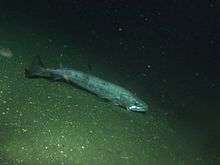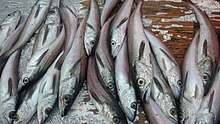North Pacific hake
The North Pacific hake, Pacific hake, Pacific whiting, or jack salmon (Merluccius productus) is a ray-finned fish in the genus Merluccius, found in the northeast Pacific Ocean from northern Vancouver Island to the northern part of the Gulf of California. It is a silver-gray fish with black speckling, growing to a length of 90 cm (3 ft). It is a migratory offshore fish and undergoes a daily vertical migration from the surface to the seabed at depths down to about 1,000 m (3,300 ft). It is the object of an important commercial fishery off the West Coast of the United States, and annual quotas are used to prevent overfishing.
| North Pacific hake | |
|---|---|
 | |
| Scientific classification | |
| Kingdom: | Animalia |
| Phylum: | Chordata |
| Class: | Actinopterygii |
| Order: | Gadiformes |
| Family: | Merlucciidae |
| Genus: | Merluccius |
| Species: | M. productus |
| Binomial name | |
| Merluccius productus (Ayres, 1855) | |
| Synonyms | |
| |
Description

Its length is about 3 ft (90 cm) and it can live up to 20 years. Its coloration is metallic silver-gray with black speckling and pure silvery white on the belly. The North Pacific hake has two dorsal fins and a truncated caudal fin. Its pectoral fin tips usually reach to or beyond the origin of its anal fin. The caudal fin is always concave.
Reproduction
North Pacific hake spawn from January to June. They may spawn more than once per season, so absolute fecundity is difficult to determine. Historically, inshore female Pacific hake matured at 15 in (37 cm) and 4-5 years of age. Currently, length at 50% maturity for females in the Port Susan North Pacific hake population is about 8.5 in (21.5 cm), compared to 11.7 in (29.8 cm) in the 1980s. Females mature at 3-4 years of age and 13.4 to 15.7 in (34–40 cm), and nearly all males are mature by age three and as small as 11 in (28 cm).
Ecology
They occur from the surface to depths of 1,000 m (3,300 ft). North Pacific hake are nocturnal feeders that undergo daily vertical migrations off the bottom to feed on a variety of fishes and invertebrates. Their diet includes shrimp, plankton, and smaller fish such as lanternfish. They are an important prey item for sea lions, small cetaceans, and dogfish sharks.
The three recognized stocks of Pacific hake are a highly migratory offshore (or coastal) stock that ranges from southern California to Queen Charlotte Sound, a central-south Puget Sound stock, and a Strait of Georgia stock. The offshore North Pacific hake stock spawned off south-central California to Baja California in January and February during the 1960s, 1970s, and 1980s.[2][3] In spring and summer, adults migrated northward to feed to as far as central Vancouver Island (and as far as Queen Charlotte Sound in some years). In the fall, adults migrated southward toward spawning grounds. Since the early 1990s, a percentage of the offshore stock has remained off the west coast of Canada year round and some Pacific hake have been observed spawning off the west coast of Vancouver Island.[3] Resident Pacific hake in Puget Sound spawn in Port Susan and Dabob Bay from February through April. The Strait of Georgia resident stock aggregates to spawn in the deep basins of the south-central strait, where peak spawning occurs from March to May.
Fisheries and conservation

Pacific hake support one of the most important commercial fisheries off the West Coast of the United States. Of the three recognized stocks mentioned, the latter two stocks are managed by state and local management agencies, but the offshore, or coastal, fishery in U.S. waters is managed by the Pacific Fishery Management Council through its Pacific Coast Groundfish Fishery Management Plan. Originally approved in 1982, the plan now manages over 90 different species through a number of measures, including harvest guidelines, quotas, trip and landing limits, area restrictions, seasonal closures, and gear restrictions (such as minimum mesh size for nets). Annual quotas are the primary management tool used to limit the catch of hake. Pacific hake were declared overfished by the US government in 2002. The stock was declared rebuilt and no longer depleted in 2004. The coast-wide (U.S. and Canada) Pacific hake stock is assessed annually by a joint technical team of scientists from both countries.
In 2003, the U.S. and Canada signed an agreement that allocates a set percentage of the Pacific hake catch to American and Canadian fishermen over the next decade, and established a process for the review of science and the development of management recommendations. Beginning in late 2007, management of Pacific hake and related science activities was coordinated under the provisions of this international treaty with Canada.
A recent stock assessment of the coastal stock estimated that the offshore stock of Pacific hake is at a healthy level (above the management reference points) with overfishing not occurring.[4] Supported by annual stock assessments such as this, the Marine Stewardship Council certified the midwater Pacific hake (whiting) fishery on the coastal stock in the U.S. and Canada as sustainable in 2009 and renewed the certification in 2014.[5]
The local and state-managed Puget Sound and Strait of Georgia stocks are "species of concern" - species that NOAA Fisheries Service has concerns about regarding population status and threats, but has insufficient information to indicate a need to list the species under the Endangered Species Act (ESA). No directed commercial fishery for this stock has occurred since 1991.
The National Marine Fisheries Service received a petition to list the North Pacific hake under the ESA. The petition was denied on 24 November 2000 (65 FR 70514), but concerns and uncertainties remained. During the review for ESA listing, the Georgia Basin distinct population segment (DPS) was identified to include both the Puget Sound and Strait of Georgia stocks. The Georgia Basin DPS of the North Pacific hake (called Pacific hake by NMFS) was made a US National Marine Fisheries Service species of concern. Species of concern are those species about which the National Oceanic and Atmospheric Administration, National Marine Fisheries Service, has some concerns regarding status and threats, but for which insufficient information is available to indicate a need to list the species under the ESA.
Potential range expansion by Humboldt squid has been a cause for concern, because they are predators of hake.[6]
References
- Iwamoto, T.; Eschmeyer, W.; Alvarado, J. & Bussing, W. (2010). "Merluccius productus". IUCN Red List of Threatened Species. 2010: e.T183411A8108892. doi:10.2305/IUCN.UK.2010-3.RLTS.T183411A8108892.en.
- Methot and Dorn 1995.
- McFarlane et al. 2000.
- Berger AM, Grandin, CJ, Taylor, IG, Edwards, AM, Cox, S, Status of the Pacific Hake (whiting) stock in U.S. and Canadian waters in 2017 (PDF), Prepared by the Joint Technical Committee of the U.S. and Canada Pacific Hake/Whiting Agreement, National Marine Fisheries Service and Fisheries and Oceans Canada.
- "Pacific hake mid-water trawl fishery earns MSC re-certification". 25 November 2014. Retrieved 15 March 2018.
- Zeidberg, Louis D.; Robison, Bruce H. (2007), "Invasive range expansion by the Humboldt squid, Dosidicus gigas, in the eastern North Pacific", PNAS, 104 (31): 12948–12950, doi:10.1073/pnas.0702043104, PMC 1937572, PMID 17646649
Further reading
- McFarlane, G. A.; King, J. R. & Beamish, R. J. (2000), "Have there been recent changes in climate? Ask the fish", Progr. Oceanogr., 47 (2–4): 147–169, doi:10.1016/S0079-6611(00)00034-3.
- Methot, R. D. & Dorn, M. W. (1995), "Biology and fisheries of North Pacific hake (Merluccius productus)", in Alheit, J. & Pitcher, T. J. (eds.), Hake: Biology, fisheries and markets, London: Chapman & Hall, pp. 389–414.
External links
- Froese, Rainer and Pauly, Daniel, eds. (2006). "Merluccius productus" in FishBase. April 2006 version.
